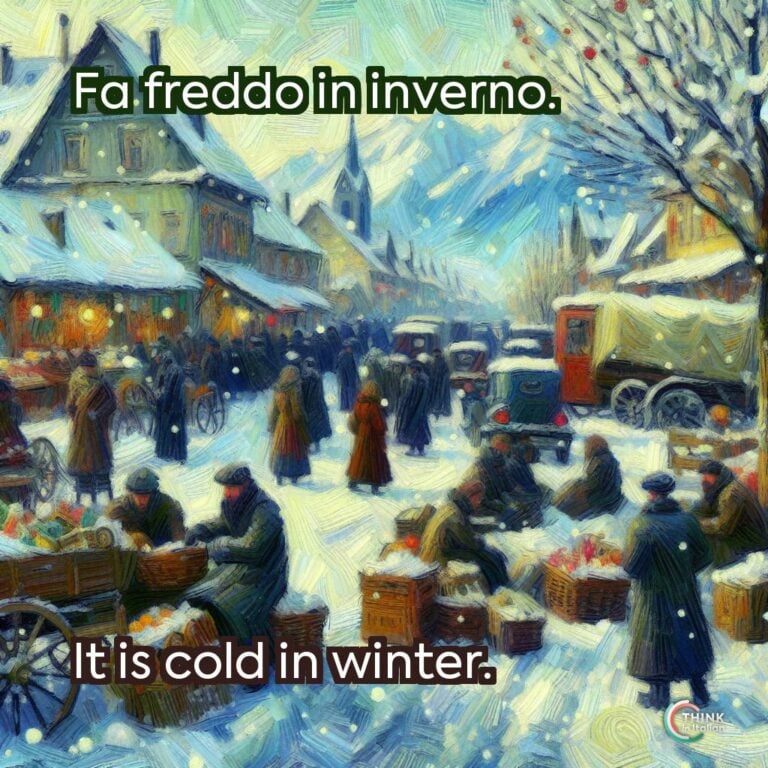Italian Verbs: an Introduction
Italian Verbs Conjugations
Italian verbs can be divided into three groups based on their conjugations, that is, the ending of their infinitive forms, which affects the way the verb is, indeed, conjugated. The three Italian conjugations are -ARE, -ERE, -IRE:
- First conjugation (verbs end in – are): mangiare (= to eat), lavorare (= to work), studiare (= to study).
- Second conjugation (verbs end in – ere): leggere (=to read), perdere (= to lose), vivere (= to live).
- Third conjugation (verbs end in – ire): dormire (= to sleep), capire (= to understand), preferire (= to prefer).
In linguistics, the vowel that changes and allows to determine the verb conjugation is called thematic vowel. When you conjugate a verb in Italian, its root displays semantic information – the meaning of the verb – , while its ending displays the following grammatical information:
- Subject (person and number)
- Verb mood and tense
- Verb conjugation
Let me show you an example:
LAVORARE – lavorano
Where lavor is the root, displaying the meaning of the verb (to work) and –ano is the ending, displaying the verb conjugation (first), the verb tense (indicative present), and the subject (third person plural).
Almost all Italian first-conjugation verbs are regular. Irregular verbs usually belong to the second and third conjugation.
Italian Verbs Moods and Tenses
Italian is a very rich language in terms of verbal system. It has different moods and tenses. Here, I will show you the present tense of the indicative mood, but I believe it is important you are familiar with the entire verb organization in general.
I made this table which shows the first person singular conjugation of all verb tenses and moods. Notice that, for the imperative mood, I used the second person singular.
| Mood | Tense | Conjugation |
|---|---|---|
| Indicativo | Presente (Present) | studio |
| Imperfetto (Imperfect) | studiavo | |
| Passato remoto (Remote Past) | studiai | |
| Futuro semplice (Simple Future) | studierò | |
| Passato prossimo (Present Perfect) | ho studiato | |
| Trapassato prossimo (Past Perfect) | avevo studiato | |
| Trapassato remoto (Preterite Perfect) | ebbi studiato | |
| Futuro anteriore (Future Perfect) | avrò studiato | |
| Congiuntivo | Presente (Present) | studi |
| Imperfetto (Imperfect) | studiassi | |
| Passato (Past) | abbia studiato | |
| Trapassato (Past Perfect) | avessi studiato | |
| Condizionale | Presente (Present) | studierei |
| Passato (Past) | avrei studiato | |
| Imperativo | Presente (Present) | studia |
| Infinito | Presente (Present) | studiare |
| Passato (Past) | avere studiato | |
| Participio | Presente (Present) | studiante |
| Passato (Past) | studiato | |
| Gerundio | Presente (Present) | studiando |
| Passato (Past) | avendo studiato |
Here, I will discuss the present tense of the indicative mood. Precisely, irregular verbs only. If you want to know more about regular present tense, have a look at the relevant grammar lesson!
Italian Present Tense
Conjugation
While all regular verbs in the present tense are conjugated by removing the infinitive ending are, ere, or ire and by adding the corresponding endings, with irregular verbs the situation is different.
Irregular verbs change their entire root when being conjugated. The endings – that is, the conjugation itself – are the same as the regular verbs, but their root is different, which makes learning them a bit harder.
Here are some first conjugation irregular verbs (ending in – are):
| Irregular verbs – Present Tense (First Conjugation) | ||||
| andare (to go) | dare (to give) | fare (to do/make) | stare (to stay) | |
| io | vado | do | faccio | sto |
| tu | vai | dai | fai | stai |
| lui/lei | va | dà | fa | sta |
| noi | andiamo | diamo | facciamo | stiamo |
| voi | andate | date | fate | state |
| loro | vanno | danno | fanno | stanno |
Here are some second conjugation irregular verbs (ending in – ere):
| Irregular verbs – Present Tense (Second Conjugation) | ||||
| essere (to be) | avere (to have) | sapere (to know) | bere (to drink) | |
| io | sono | ho | so | bevo |
| tu | sei | hai | sai | bevi |
| lui/lei | è | ha | sa | beve |
| noi | siamo | abbiamo | sappiamo | beviamo |
| voi | siete | avete | sapete | bevete |
| loro | sono | hanno | sanno | bevono |
Here are some third conjugation irregular verbs (ending in – ire):
| Irregular verbs – Present Tense (Third Conjugation) | ||||
| dire (to say) | venire (to come) | uscire (to go out) | salire (to go up) | |
| io | dico | vengo | esco | salgo |
| tu | dici | vieni | esci | sali |
| lui/lei | dice | viene | esce | sale |
| noi | diciamo | veniamo | usciamo | saliamo |
| voi | dite | venite | uscite | salite |
| loro | dicono | vengono | escono | salgono |
Use
In Italian, the present tense is used to:
- talk about actions that are currently happening:
Lucia vive a Bologna.
Lucia lives in Bologna.
Oggi lavoroda casa.
I’m working from home today.
However, notice that if you want to stress out that an action or event is occurring right now, you can use the progressive tense (-ing form).
- talk about general truths:
L’acqua bolle a 100 gradi.
Water boils at 100 degrees.
Le tigri non vivono in Africa.
Tigers don’t live in Africa.
- talk about habits and recurrent actions currently happening:
Mangio due piatti di pasta al giorno.
I eat pasta twice a day.
Tutte le sere leggo un po’ prima di andare a dormire.
Every evening I read for a bit before I go to sleep.
- talk about future actions if the time of the action is clear:
Domani torno a casa.
I’m going back home tomorrow.
Verb: Centre of the Sentence
Learning irregular verbs might result a bit harder, but it is essential if you want to learn a new language. Verbs are the most important element of a sentence. They affect the choice of the subject, the objects, their relative prepositions etc…
Let me tell you a secret about how your brain works when learning irregular verbs.
There are two main types of long-term memory that comes into play when learning a language: procedural memory and declarative memory.
Procedural memory allows to automatically use language without having to think about every step. It makes using grammar correctly, pronouncing words right, and using phrases naturally much smoother.
Declarative memory allows you to remember specific information about the language, such as remembering words and what they mean, that is, the language vocabulary.
When it comes to learning irregular words, you will be using the declarative part of your memory, because you have to learn that a certain word has a certain form no matter what.
Therefore my advice is that you practice a lot, and if you don’t have a conversation partner, take advantage of our Italian AI tutor to engage in unlimited conversations based on your level.
You can personalize your conversations and, for instance, you can choose to speak only in present tense and get instant feedback on your errors.
You have just taken the first step!




